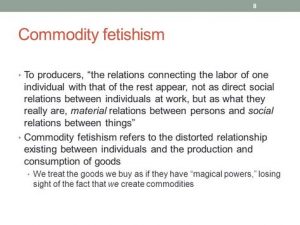(ThyBlackMan.com) Commodity Fetishism is the idea that it is natural and inevitable to measure the value of things with money, instead of measuring the value of things by the time and energy put into making them. In Karl’s Marx’s “The fetishism of Commodities and The Secret Thereof” he defines commodity fetishism as the “perception of the social relationships involved in production, not as relationships among people, but as economic relationships among the money and commodities exchanged in market trade” (Marx pg. 319). In today’s modern era, the ideas that Karl Marx pondered about way back when, are starting to emerge within both the Latino and Black communities. Commodity fetishism can be seen in many products in today’s society in both communities. Three products that I will use to compare both communities to Karl Marx idea of Commodity Fetishism, are Chocolate, Apple, and Jordan. Further, I will compare and discuss the ideas of Anne McClintock in her article ‘Soft-Soaping Empire: Commodity Racism and Imperial advertising” who has a similar yet different approach to commodity fetishism. McClintock in her article states that the rise of the industrialization in the late nineteenth century caused manufacturers to advertise their products more heavily to a “growing middle class”, which was heavily dominated by Caucasian people. In doing so, objects were starting to no longer be made for their practical purposes, “but also as the fundamental form of a new cultural system for representing social values” (McClintock 507). I will use Karl Marx’s theory of commodity fetishism to enhance McClintocks analysis of how soap advertisements promoted in Britain’s imperialist agenda that discriminated against people of color.
In the past century, chocolate has become a “fetishized commodity”. The majority of people buy a certain kind of chocolate not because of how it was made, but because of the way it is advertised to the consumer. Chocolates like Ghirardelli, Lindor, and Godiva for example promote a more sophisticated chocolate and uses powerful imagery to convince the consumer that they can too have an experience of high-class luxury by having their chocolate. They promote the idea that consumers of their chocolate are in some way “higher class” and more “tasteful” than people who do not consume their chocolate. Because of this reason their chocolates have a higher price tag than the everyday, $1 chocolate that a person would buy from the corner bodega. Making the $1 chocolates intended for the “lower-class” consumers.
Even though both kinds of chocolates are made through a similar process with the same basic ingredients. As a society we give more value to the Godivas, Lindor, and Ghiardelli chocolates because we take into account their price value and the imagery of how much they should cost to us, more than the labor that was put in to make the chocolate. Many chocolate fanatics argue that Godiva chocolates taste like sugar and candle wax, not meeting the criteria’s to be a real elite chocolate. But the reputation of Godiva as a luxurious chocolate is enough to satisfy many of the non-fanatics of chocolates, so it maintains it high price value. Hoping to make profits because of the trend, many popular brands like M&M for example release their own line of “high end” chocolates. They will then have a low-production cost, like always, but will be able to sell it at a higher price because it will now be considered a high end chocolate.
Marx would see this status-symbol chocolate advertising as a prime example of how fetishism helps capitalism. This kind of advertising reinforces the idea most people have of the elite class and shows that being part of the elite class is something to want.
The value that we put on a product has as much to do, if not more with the way the world and the community around us thinks of that products. Apple for example, is another product that makes their money on creating the need that their product enhances a person’s lifestyle. Apple has created an image for their company where having an apple product puts you above others. Apple is the modern day textbook example of commodity fetishism. Marx wrote that “the whole mystery of commodities, all the magic and necromancy that surrounds the products of labor as long as they take form of commodities” (Marx pg. 323).
Marx is saying that commodities have a worth that do not come from the fact that people made the product. But instead the relationship between the labor and the product was strange “the social relationship that creates (the commodities) equal value (the amount of labor which they embody) disappears from our consciousness” (Marx pg. 323). Which is then replaced by a market price, that changes life into a “material relationship between things” (Marx pg. 323). Commodities then start to have an “objective value” different from “their physical properties and with the material relations arising therefrom” (Marx pg. 323). So what then really matters with any commodity is not how it came to be made or what it does but what matters is how it is perceived culturally, and how much it is desired by those around us.
Apple is one of the most obvious and widespread example of this idea. The vibe, surrounding an iPod, iPad, or iPhone has very little to do with the labor that went into making the product itself. “The fetishism, the religious nature of apple goods, is linked to the image Apple marketing has sold to purchasers of the product which becomes a ‘real’ quality once they have acquired it. Apple users are hip, futuristic, minimalist, and part of a select group once they own that item. In this way it’s no different than people who buy a hybrid car or BMW; Apple is just more ubiquitous because it’s cheaper than exclusive cars” (Daniels pg. 1). Evidence of this commodity fetishism with Apple products can be seen in the social affects that these commodities have on society.
For example, when a new Apple product comes out, it has become socially acceptable for people to get in long lines outside of Apple stores hours in advance in order to be one of the first to own the latest technology. People forget about the labor needed to create this commodity and instead focus on its exchange value and social effect. The demand of such products, like iPhones, causes the need for more production of the commodity and leads to worker’s alienation. Commodity fetishism causes a social relation between the owners and their workers. The combination of social relation and the fetishism with the commodity leads and deepens the alienation felt by the worker. “Because of commodity fetishism, consumers only care for the product and not the value and the labor put behind each product and not the value and the labor put behind each product by a wageworker, making the consumer blind to alienation” (Yaller pg. 1).
Jordan is another product that has used commodity fetishism to its advantage. A prime example of this was when Michael Jordan, in 1992 received twenty million dollars from Nike so he can add his name, “creativity” and “final touches” on Nike shoes. What he received to be a part of Nike was more than the total wages of all the women in South East Asia who were actually making the shoes. Nike knew, that people value more how a product is perceived by others rather than the worth of the labor that is put into it. That’s why they invested 20 million dollars to involve an athlete that they knew most people saw as admirable. Rather than to use that money to motivate the women who were making the shoe or creating more jobs for the women in South East Asia.
In a capitalist society, Marx said, “the exchange value of a good inevitably dominates its use value because the production, distribution, and exchange of goods and services will always be dictated by the price they can command-hence their profitability- rather than by the satisfaction of real needs” (Marx pg. 325). An example of this is that a pair of Air Jordan XV retails for $150. Fetishism of commodities gives us this idea of false consciousness where we have the price we pay for these products rather than their actual utility.
According to John Cavanagh, an economist and the director of the institute for Policy Studies, a typical pair of Jordan shoes costs about $5.60 to produce in Asia, and the women who make Nike shoes are paid about $1.35 an hour. A person who is working to make these shoes, working about fifty-hours a week will have to spend 50% of their monthly income to buy a pair of Air Jordan XV for their teenage son for example. Amazingly the added value that the Jordan endorsement brings to the company, spreads to the rest of their products. For example, there is no Air Jordan model for woman bur you can still “spend $140 on a pair of Air Max Deluxe…You can buy a cute pair of little Air Jordan XV for an expectant girlfriend for twenty-four dollars plus tax, or about a fifty cents per day given how long the baby could wear them… if the celebrity value isn’t inherent in these little itty-bitty shoes, what makes them so expensive?” (Collins pg. 3). This is a perfect example to Karl’s Marx idea of people valuing commodities by how much money they see tied into it. Instead of valuing it by the labor that was used to make the commodity.
Marx describes commodity fetishism as a process where humans give value to natural objects that become transformed through labor. The famous example that he uses is how laborers can turn wood into a table. By taking a natural product and changing it to a commodity, there is now social meaning tied to that commodity. (Ex. Turning wood into a table might give that table meanings like family, community, meals, etc). According to Marx, after these commodities are made they have a certain value that is not connected “with their physical properties and with the material relations arising therefrom” (Marx pg. 206).
However, there are certain commodities that have specific meanings depending on who is consuming them. Which is one of the ideas that McClintock is bringing to the table. With the rise of industrialization, an object like soap that was once a luxury item that only the higher class had access to. Can now be distributed to a then growing middle class. “that could afford for the first time to consume such goods in large quantities” (McClintock 508). Since soap became a more accessible and widely distributed commodity, it started to have a different social meaning. More people were now coming into contact with it and advertisers needed to attract the commodity to these new consumers of their product.
Advertisers of these soap companies started to note the rise, so they were constantly coming up with different marketing strategies to attract consumers. During the late 1800s Britain was expanding their empire, so soap advertisers saw this as an opportunity for marketing their product to be a part of Britain’s imperialist image: “Soap was credited not only with bringing moral and economic salvation to Britain’s ‘great unwashed’ but also with magically embodying the spiritual ingredient of the imperial mission itself” (McClintock 509). Pears’, a popular soap company in Britain at the time, marketed their soap as a commodity that would help the “purification of the domestic body by having advertisements of a white child washing the body of a black child to make him white” (McClintock 511). Marx would had seen this advertising strategy as a way to use commodity fetishism by giving an emotional and social value to commodity to create a “fantastic form of a relation between things” (Marx pg. 206). Soap companies in Great Britain in the late 1800s did not want consumers to look at soap and think about the chemical processes that were done to create it, they wanted them to think about racial cleanliness.
Pears Soap strategy is a metaphor to Marx’s commodity of fetishisms because according to Marx, a producer must have a “definite useful kind of labor, satisfy a definite social want,” (Marx 207). which for Pears Soap it would be its hygiene component but in addition, the work “can satisfy the manifold wants of the individual producer himself” (Marx 207). Which for Pears it would had been to promote an imperialist idea about purifying Britain’s empire to attract consumers by connecting to them emotionally. By buying Pears Soap, consumers are becoming a part of Britain’s mission to purify its empire. Individuals were not only interested in the soaps hygienic component but also its symbolic value of “decontamination and regeneration of the body politic” (McClintock 511).
British advertising combined images of domesticity with images of the empire. It took scenes of domesticity and made them public. Victorian advertising showed the British empire as an organized system of images and it reached a large number of its people via mass marketing. This was a way of redefining racial differences. The British used the images in advertising to support what they though was dominance. Anne McClintock states, “Victorian cleaning rituals were peddled as globally as the God-given sign of Britain’s evolutionary superiority, and soap was invested with magical, fetish powers”. (McClintock pg. 43). Soap became a symbol of British superiority due to its association with hygiene and its symbolism of progress.
This was the beginning for what Anne McClintock termed “commodity racism” in which she states, “Commodity racism became distinct from scientific racism in its capacity to expand beyond the literate, propertied elite through the marketing of commodity spectacle” (McClintock pg. 16). Later on she goes ahead and explains the meaning of ‘commodity racism,’ “No pre-existing form of organized racism had ever before been able to reach so large and so differentiated a mass of the populace” (McClintock pg. 16). The ideas of racism in Britain now reached a bigger audience due to the use of pictures instead of literature.
McClintocks ideas of Commodity Racism and Imperial Advertising can be compared to social media in the 21st century, just like how I compared Karl Marx’s commodity fetishism to chocolate, Apple, and Jordan. Despite it being decades after the civil rights movement that ended racial segregation, Racism is still very alive in media today, especially on social networking websites such as Twitter and Facebook. It has been argued that social media can be used to have people who share abusive or discriminative views do so freely which can be compared to commodity racism in the Victorian era.
A great example of this was during the re-election of America’s first black president Barack Obama, an event that started an ugly lash back of racial slurs on social networking websites. Tweets were posted that referred Obama as a “Nigger”, a “monkey” and a “ratchet minority”. There were Twitter users who were posting hate speeches calling for the south to “rise again”, that a black man should not lead this country or live in a “white house”. People on social media were comparing Obama to Mitt Romney, his competing candidate in the election. Saying that Mitt Romney has better “morals” and is superior because he is white. You can similarly compare this to the Pears Soap advertisements where the white boy is superior and better than his black friend because of his race. This example highlights how racism is still very much alive in Social Media in the 21st century society that we live in.
Marx, Karl, and Friedrich Engels. Karl Marx and Frederick Engels; selected works in one volume. Vol. 1, International Publishers, 1968.
McClintock, Anne, and George Robertson. Soft-Soaping Empire: Commodity Racism and Imperial Advertising. Routledge, 1994.
Collins, Sue. “”E” Ticket To Nike Town.” Nyu.edu, e-Journal of Culture and Communication, Nov. 2001, http://www.nyu.edu/pubs/counterblast/beta/issue1_nov01/pdf_files/collins.pdf.
Fahim, Jamal. “Chocolate and Commodity Fetishism – Sociological Images.” Sociological Images Chocolate and Commodity Fetishism Comments, The Society Pages, 15 Nov. 2010, http://thesocietypages.org/socimages/2010/11/15/guest-post-chocolate-commodity-fetishism-and-high-class-luxury/.
Daniels, Breanna Ray. “Chocolate, iPhone, and Commodity Fetishism.” Communication and Popular Culture, Stein Pop Culture, 11 Jan. 2017, http://steinpopculture.blogspot.com/2017/01/chocolate-apple-and-commodity-fetishism.html
Staff Writer; Melvin Santiago

















Leave a Reply